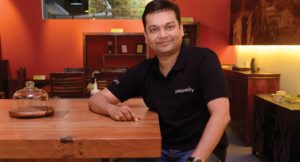Helpshift, a customer support platform, is installed in almost 1.30 million devices worldwide and serves more than 300 million mobile customers on a monthly basis. With a recent funding round of US $23 million from Microsoft Ventures and Salesforce Ventures, the company is gearing up for further growth.

“When was the last time you spoke to somebody from customer service?” quizzes Abhinash Tripathy, CEO and Co-founder, Helpshift, as we start our conversation. It so happened that I had a frustrating conversation with a service provider’s customer desk that morning and my response was an exasperated, “Yea, just now!” which he takes immediate note of. This isn’t news to any of you as it’s an experience many relate to. Tripathy gets into some numbers that help us understand the magnitude of this issue and potential of the market in which his company operates. He says, “Globally, about US $120 million is spent on contact centres and US $30 million on CRM. To put it differently, in the U.S., almost four per cent of the GDP is employed in contact centres and yet, the service experience is so broken.” At the time, this was an underserved area which held huge potential for a company like Helpshift, which aimed to improve and enhance the service experience. This was also the period when products and services where moving into smart phone apps. So, the founding team of Helpshift decided to marry the two problems; that of poor customer service and adoption of smart phone apps and come out with a solution – a customer support platform for mobile and the web, in 2012.
The company looked for the most common behaviour on a smart phone, which is messaging, and introduced a messaging feature into the app and eliminated other inefficiencies in the process. “You don’t have to contact a call centre and put your life on hold for 30 minutes. We got rid of that by bringing this paradigm into our solution,” says the co-founder.
Through an intuitive user interface Helpshift makes it easy for businesses to support and engage their customers. Its support platform include functions such as in-app FAQs, in-app chat, a full CRM ticketing system, in-app campaigns and in-app surveys, making it easy for companies to provide a best-in-class customer support experience on any device.
Today, its app is installed in almost 1.30 million devices worldwide and serves more than 300 million mobile customers, monthly. The company recently closed a US $23 million Series B with participation from new investors, Microsoft Ventures, Salesforce Ventures and all previously existing investors, including Intel Capital, Nexus Venture Partners, True Ventures and Visionnaire Ventures bringing its total capital raised to US $36.2 million.
Being an entrepreneur is about trying to change the world in a new and meaningful way. We were the ones to create this app and now we see the rest of the industry following us. We think we can effect big change and the change we want to effect is to make customer service a very pleasurable experience
Courting gamers
“We are probably one of the few companies that started our operations in India with a majority of sales from the global markets,” states Tripathy. To achieve this, the company set up local sales and marketing teams in the markets where it has a presence. It is going after a business model where it builds high quality products with an aim of selling to large customers. “To succeed, one of the most important prerequisites is to build a good sales and marketing capability outside of India,” adds Tripathy.
The company raised its first capital in 2012 and went to market with its product in 2013. It took nearly seven months to build the product and launched the product in early 2013. “It was a challenging year as we were introducing a new way to do customer service and took about a year to educate the market,” recalls Tripathy. While its product can be used horizontally, the early adopters of its technology were largely the mobile gaming segment. To put things in perspective, he says, “Last year, US $30 billion was made on the app store – between Apple and Google, out of which 85 per cent went to gaming companies. As a lot of money is made here, services need to be provided on a very high scale which is what our solution is all about.” Tripathy shares a note on the company’s very first customer, Lemon Wallet – a financial app company. “We learnt a lot from them and eventually, started working with a bunch of small gaming companies – Pixelberry Studios was our first marquee gaming company,” he recalls. Today, Helpshift boasts of a clientele that includes large brands such as Microsoft, Target, VirginMedia, Zynga, Flipboard, Luxe, WordPress, Nickelodeon and more.
While the company focussed on the gaming vertical in 2014, from 2015, it started selling to other large consumers that offer productivity tools. Citing an example, Tripathy says, “We are embedded in Microsoft Outlook app and are now going to other MS products.” Apart from these two sectors, in the coming years, the company also plans to focus on segments like e-commerce, financial services and banking and Internet of things.
Focusing on growth
Helpshift charges its customers for the number of users on its app. For a large gaming company, it bills them based on the monthly active users. It also charges for the number of agents that respond to these customers.
It has a team of 90 people out of which 65 are based in Pune, India, where it’s engineering and R&D facility is housed while the other 25 are based in San Francisco. It has a small sales force in London too. Almost 97 per cent of its business is from the global market – 40 per cent to 45 per cent are U.S. customers while the rest are distributed between China, Hong Kong and Europe.
Talking about its growth, Tripathy says, while the company was set up in 2010, for two years it ran like a lab. A sharper focus on Helpshift’s business model came about only in 2012, when it raised money. “In 2013, there was no sales as we were introducing the product to the market,” he shares. In 2014, the company grew by 400 per cent, while in 2015 it grew by 300 per cent and hopes to maintain the same growth rate in this fiscal. For Tripathy, one of the biggest measures of progress is a presence on all available devices and this is something the company never loses sight of.
Learning to adapt
For Tripathy, raising money was not a challenge as he’s not a first time entrepreneur. “In 2012, we tried to raise a seed round in the U.S. with a product which was not exactly what Helpshift offers today, but, more of a CRM category product,” recalls Tripathy. After four meetings with VCs, the founding team realised that with this product it was going to be hard penetrate the market as it offered very little differentiation from others in the industry. And hence, it brought in mobile and smart phone apps into its product and made that a part of its solution. “After this, we went to True Ventures with a plan on the whiteboard and they were excited with it and wrote the first cheque,” says Tripathy. He adds, “When VCs give you concrete, actionable feedback, it is easy to make changes. We took their feedback and flipped our story overnight and within a week we raised money.” The company has so far raised US $36.20 million from Microsoft Ventures, Salesforce Ventures, True Ventures, Visionnaire Ventures, Nexus Venture Partners and Intel capital.
Using these funds, it is going to further expand its market base. While CRM has existed for the B2B segment, Helpshift is going after the large B2C companies from sectors such as e-commerce, financial services and banking and Internet of things. “Competition is based on how we achieve scale. A B2B solution gets about a 1,000 customers contacting them per day. However, B2C companies have about 1,00,000 customers per company contacting them every day. That is the scale at which we are operating,” says Tripathy. B2C is a new category and Helpshift wants to see this become as big as the B2B category and be instrumental in driving this market. “We are all set to play a large part in a market that is likely to generate US $20 billion to US $30 billion business globally,” concludes a confident Tripathy.




